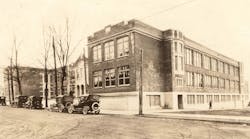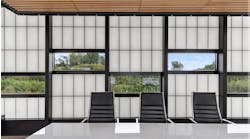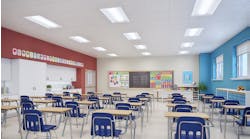For decades, schools of all shapes and sizes – whether primary, secondary or higher education – have led the industry in designing daylight into their projects. In parallel, industry and academia have taught designers and builders techniques, technologies, and testing necessary to provide the appropriate quantity and quality of light for the built environment.
However, there remains one caveat to the relative success of incorporating daylight in schools: the unchanging expectations of owners, designers, operators and occupants. Most designers and owners set project targets based around the same static illumination requirements dictated by electric lighting design. All too frequently daylighting is simply seen as an alternative to electric lighting for supplying a constant level of lumens to a space, rather than as an opportunity to create a more dynamic environment based on light levels that transition throughout the day. All lumens are not created equally.
A Brief History of Light
The architecture of early 20th century schools typically featured classrooms with large windows that allowed daylight to flood into the space. This was necessary since, at that time, daylight was the primary source of lighting. This period of school architecture focused on double loaded corridors that maximized access to daylight in perimeter rooms while using transom windows to provide modest illumination to the central corridors. It was not until the advent of affordable electric fluorescent lighting during the mid 20th century that daylighting became superfluous.
With the oil embargos of the 1960s and ’70s and the subsequent energy crisis, school architecture evolved again. Natural light became an unsupportable luxury due to costs associated with heating and cooling those rooms. Many classroom buildings began to move corridors to the perimeter leaving windowless classrooms on the interior. Offices and student centers dramatically minimized the number and size of windows.
A fundamental switch in occupant expectations occurred along with this change in design philosophy. Buildings now had the ability to provide constant, unchanging light levels and unvarying, continuous luminance patterns. This static, benign environment was commonly considered beneficial – a distraction-free environment for learning. Couple this with the increasing introduction of electronic technology, and the result was an architectural ecosystem that was purposefully and desirably conceived as an unnatural environment.
Flipping the Switch
The pendulum has thankfully swung back. There is an increasingly strong push to actively introduce natural light into new construction, especially within school facilities. Though it is often introduced based on the quantitative potential for reducing lighting energy, it’s the qualitative improvements to the built environment that are orders of magnitude more valuable. By improving design elements directly related to how occupants engage the space, “the connection to the outdoors” is leveraged to realize a higher performance for all facilities. The industry report “Economics of Biophilia” produced by Terrapin Bright Green, provides a summary of the current research that shows daylighting to conclusively improve learning rates, increase worker satisfaction, increase retail sales, and reduce healing times, amongst other benefits. It is these non-energy benefits that are at risk when the common expectations for a benign environment are applied to a daylit space.
To understand this physiological relationship, we must first understand the inherently dynamic character of natural light. The daily illuminance intensity ranges from 0.01 footcandles (fc) for moonlight to 10,000 fc for noontime sun – a range of 1 to 1 million. Daily, color temperatures vary dramatically from roughly 1800K (orange) during sunrise and sunset to 5500K for direct sun (light blue). When the clouds roll in, the color temperature increases to at least 6500K (blue), while nighttime moonlight provides a color temperature around 4000K (white). It is this dynamic essence of natural light that impacts circadian rhythms; the color, intensity, and timing of light are the driving forces that balance hormonal levels within the body.
Admittedly, the industry has yet to fully understand the physiology behind why daylighting, or more accurately, why the hormonal balance provided by daylight offers such a varied and expansive set of benefits. The fear is that if the design and operational expectations of the space remain static, the full benefits of daylighting won’t be realized. In essence, a project could follow all the best design principals set forth in guides such as The Lighting Research Center’s “Patterns to Daylight Schools for People and Sustainability,” but operator and occupant behavior could inadvertently compromise the value inherent to the daylight design.
Successfully designing with daylight requires a strategy of “educate, design, and educate.” In the beginning, designers and owners need to recognize what a daylit space involves, how the space will operate, and how to maximize benefits. The design then follows, directed by a thorough understanding of the diversity and unique requirements of space types and occupancies. Upon completion, the design intent must then be communicated to the operators and occupants, otherwise the dynamic expectations and adjusted operation may be deemed as a failure.
The Space and the Occupant
A daylight design that embraces its dynamic nature begins with a consideration of the space and its occupants. Just as providing static light is not appropriate for all spaces and occupants, the level of variability must be gauged based on the individual needs of spaces. Simply put, we need to put the right type of daylight in the right type of space for the right reason. Based on the appropriate intensity, variability, and types of daylight, spaces should be assigned to one of the following five classifications:
- Sunlit – Presence of direct beam solar radiation within the space. Typically student lounges, reading areas of libraries, lobbies, dining facilities, dormitories.
- Dynamic Daylight – Larger daily and seasonal variations in light levels, movement of light apparent. Typically office areas, libraries, high traffic areas, some classrooms and athletic facilities.
- Subtle Daylight– Minimal daily and seasonal variations in light levels, little movement of light. Typically wet and dry labs, exam rooms, galleries, classrooms.
- Taste of Daylight – Psychological impact of daylight, but not consistent enough for primary source of illuminance. Typically computer labs, some athletic facilities.
- No Daylight – Spaces where daylight will negatively affect the primary purpose of the room. Typically theaters.
Electric Lighting Controls
For a sunlit, dynamic or subtle daylight approach, the design must appropriately implement a lighting control scheme that minimizes the interference from supplemental electric lighting. The space should not feel as if it is primarily illuminated with electric lighting with highlights of daylight. Rather, the electric lighting should seamlessly augment the natural light.
- Setpoint Range – The most typical photocontrol scheme utilizes electric lighting to achieve the design electric light level when the daylight cannot achieve it on its own. In this scheme, the design electric light level is deemed as an absolute minimum so the only variability occurs when the space illuminance is higher than the design value. This control scheme dilutes the natural variations in light intensity and color, while nearly eliminating any noticeable time variation. An alternative approach allows a much fuller variability within the space. A broader deadband on the photocontrols would keep the electric lighting off until the light level drops below a setpoint of 50-60 percent of the design electric light level. Once energized, the electric lighting would then ramp up to meet the design electric light level. This approach greatly reduces the interference of the electric lighting during daily variations in daylight color and intensity. A hybrid approach would be required for spaces further into the core that may lack sufficient daylight.
- Full Dimming Electric Lighting – The most serious complaints in daylight-controlled spaces involve the use of stepped or on/off controls for the electric lighting. Sudden inexplicable changes in light level are artificial and disruptive. Full dimming capabilities with a slow response allow the dynamic light levels associated with moving cloud cover to communicate the exterior condition.
- Color Temperature Adjustment – Though in its infancy, electric lighting, especially LED, can adjust color temperature. Currently, this function is mostly used in retail spaces and in galleries where differing display items benefit from various color temperatures. As this technology evolves, the potential to adjust the color temperature within a space to further reduce the interference of the electric lighting in daylit space is exciting.
Occupant and Operator Education
Finally, users must be educated to better understand the expectations for the space and how the daylight-responsive design improves it.
- No longer should occupants expect (or want) an unchanging illumination level. This will often require occupants to actively adapt, such as using local task lighting.
- Unlike casinos, occupants should be provided with visual clues that denote the passage of time. This is typically provided in the form of transient glare conditions, such as direct solar patches or reflected sunlight.
- Occupants should stop thinking of the natural environment as a distraction. Student recreational centers, cafeterias, athletic facilities, and libraries often incorporate aggressive daylighting designs and provide the highest quality daylit spaces on campus. These building types serve a more flexible or tolerant academic population. Functions within the buildings are considered less critical, and thus more conducive to a dynamic space. The key is to extend this flexibility and tolerance to classrooms, offices, laboratories, and other educational facilities.
Most educators know daylight is good, and many designers know how to design quality daylit spaces, but fewer occupants know how to engage a daylit space. Bu it is this dynamic nature of daylight that is embedded into the human psyche and physiology. As Le Corbusier once said, “Space and light and order. Those are the things that men need just as much as they need bread or a place to sleep.”
Baker, PE, LEED AP BD+C, ASHRAE HBDP, is a senior associate and Bolin, PE, LEED FELLOW, ASHRAE HBDP, is a senior vice president with the New York-based engineering firm Syska Hennessy Group, Inc.


